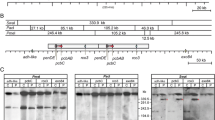Abstract
Penicillium chrysogenum is the only industrial producer of the β-lactam antibiotic penicillin. Like many other biotechnologically relevant fungi, it has been considered to be asexual, since no sexual propagation has been observed under laboratory conditions. The discovery of a sexual life cycle, the functional characterization of mating-type encoded transcription factors, and a comparative genomic analysis, however, will facilitate further improvement of P. chrysogenum strains used for industrial applications.
Similar content being viewed by others
Literatur
Dyer PS, O’Gorman CM (2011) Sexual development and cryptic sexuality in fungi: insights from Aspergillus species. FEMS Microbiol Rev 36:165–192
Kück U, Böhm J (2013) Mating type genes and cryptic sexuality as tools for genetically manipulating industrial molds. Appl Microbiol Biotechnol 97:9609–9620
Fraser JA, Heitman J (2005) Chromosomal sex-determining regions in animals, plants and fungi. Curr Opin Genet Dev 15:645–651
Pöggeler S (2001) Partnerwahl bei Hyphenpilzen–Kreuzungstypen filamentöser Ascomyceten. BIOspektrum 6:554–555
Pöggeler S (2000) Two pheromone precursor genes are transcriptionally expressed in the homothallic ascomycete Sordaria macrospora. Curr Genet 37:403–411
Becker K, Beer C, Freitag M et al. (2015) Genome-wide identification of target genes of a mating type alpha-domain transcription factor reveals functions beyond sexual development. Mol Microbiol, doi 10.111/mmi.12987
Hoff B, Pöggeler S, Kück U (2008) Eighty years after its discovery, Fleming’s Penicillium strain discloses the secret of its sex. Eukaryot Cell 7:465–470
Böhm J, Hoff B, O’Gorman CM et al. (2013) Sexual reproduction and mating-type-mediated strain development in the penicillin-producing fungus Penicillium chrysogenum. Proc Natl Acad Sci USA 110:1476–1481
Böhm J, Dahlmann TA, Gümüser H et al. (2015) A MAT1-2 wild-type strain from Penicillium chrysogenum: functional mating-type locus characterization, genome sequencing, and mating with an industrial penicillin-producing strain. Mol Microbiol 95:859–874
Nowrousian M (2013) Genomsequenzierung zur Identifikation von Mutanten. BIOspektrum 1:25–27
Author information
Authors and Affiliations
Corresponding author
Additional information
Die Arbeiten der Autoren (Tim Dahlmann, Julia Böhm, Kordula Becker, Ulrich Kück, v. l. n. r.) im Labor für „Biotechnologie der Pilze“ am Lehrstuhl für Allgemeine und Molekulare Botanik an der Ruhr-Universität Bochum werden durch die Christian-Doppler Gesellschaft (Wien) und die Sandoz GmbH (Kundl) unterstützt. Hauptarbeitsgebiet ist die genetische Manipulation industriell genutzter Schimmelpilze. Dabei kommen sowohl Methoden der klassischen Mikrobiologie und Genetik als auch moderne Techniken der funktionellen Genomik zum Einsatz.
Rights and permissions
About this article
Cite this article
Becker, K., Böhm, J., Dahlmann, T. et al. Sex und Penicillin-Biosynthese in Schimmelpilzen. Biospektrum 21, 270–272 (2015). https://doi.org/10.1007/s12268-015-0571-1
Published:
Issue Date:
DOI: https://doi.org/10.1007/s12268-015-0571-1




